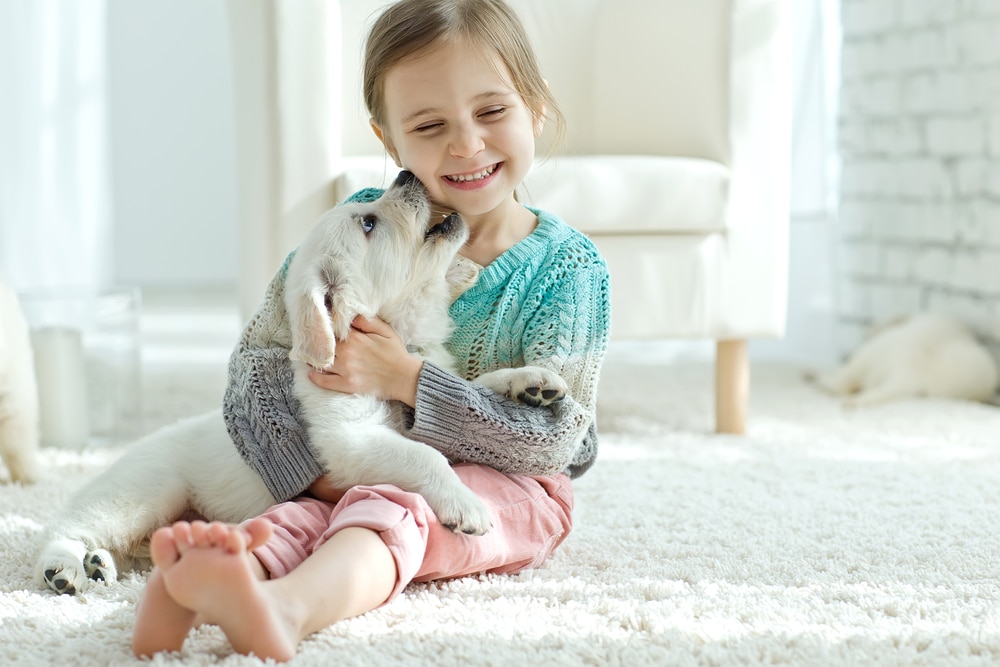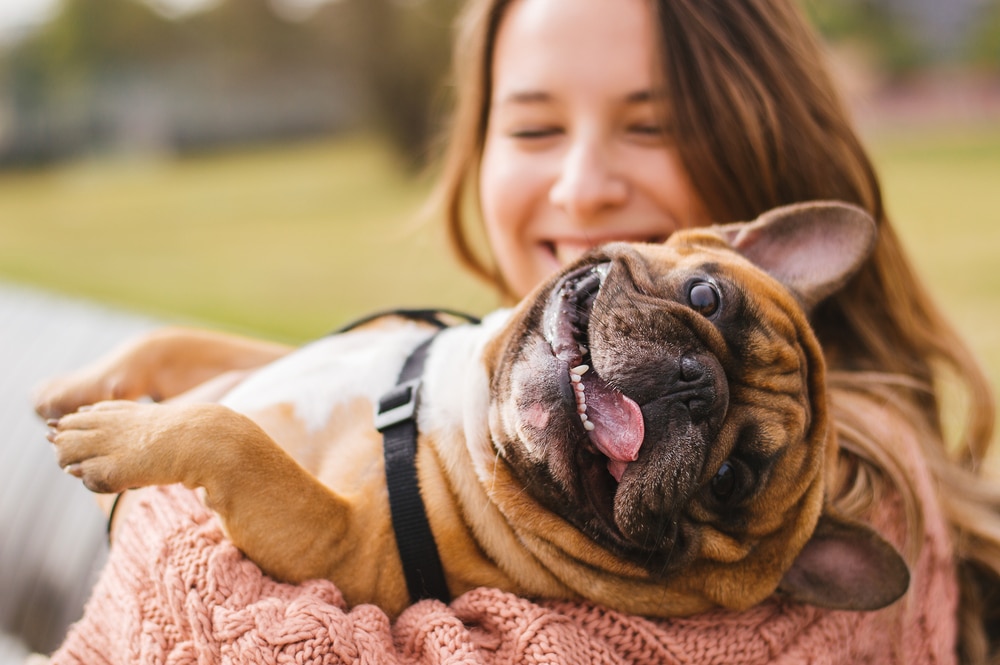The unshakeable bond we share with our doggy companions today is the delightful consequence of thousands of years of co-evolution. But what is it that happened all those years ago? How did dogs and people become friends?
Human influence likely caused the divergence of dogs from their wolf ancestors that allows dogs as we know them to exist today. Along the way, dogs that offered the best protection, hunting performance, and companionship were accepted and taken care of, making them more likely to survive and pass down those desirable traits. Being the first ever animal to be domesticated, they’ve had lots of time to perfect the art of being man’s best friend.
Table of Contents
Domestication Of The Dog – The Beginning Of How People And Dogs Became Friends
To figure out how people and dogs became friends, we’ll need to start way, way back. Let’s get to it.
Early Evidence Of Association
The exact timeline of canine domestication is a hotly debated topic. The remains of the Bonn-Oberkassel dog found buried with two humans, date back to over 14,000 years ago and present the first undisputed evidence of our historical friendship. However, there is also indefinite evidence of dogs’ divergence from their wolf ancestors over 30,000 years ago, thought to be initiated by the long-term alliance between wolves and hunter-gatherers from way back then.
What we know for sure is that the domestication of the dog predates modern agriculture. Sheep, goats, and pigs were next to assimilate into human civilization, but this occurred much later, only around 8,000 years ago. Of the 40-ish species we have domesticated since then, the dog remains the only large carnivore on that list, one with whom we have developed such an intimate alliance.
Arguably, they are also the only species whose purpose is not largely utilitarian. In the modern world, people raise the vast majority of dogs as part of the family for companionship. This is instead of for any functional purpose.
Why Wolves?
If we picture ourselves as early hunter-gatherers, it becomes difficult to imagine how a large untamed predator such as a wolf would seem an engaging companion. The exact pattern of canine domestication remains undefined. Unlike food animals, which were carefully chosen by humans based on functional characteristics, dogs may have made the first move and chosen us instead.
Commensalism
Perhaps it is the audacious nature specific to predators that emboldened the wolves to approach people. From there, the ones that were more curious and altruistic rather than vicious and untameable were more likely to be welcomed into human society. At least in its initial stages, our relationship with wolves seemed to have been a commensal one. This is when one species benefits and the other derives neither benefit nor harm.
Wolves are omnivores, able to eat things other than just meat, and able to hunt and feed themselves. Studies show these wolves living on the edges of human society even evolved different guts. Those guts were better at digesting fat and helped them to survive on the scraps discarded by humans after a hunt. They placed no burden on their human comrades and were of a manageable size. All these criteria made them the perfect first candidate to coexist with early humans.
The Stages Of Domestication
Theoretically, the domestication of the dog occurred in three stages. In the first commensal stage, natural selection favored pluckier wolves who approached humans and received the benefits of food scraps and shelter. Of these, people artificially selected and welcomed into their families wolves with a tame or even friendly disposition. Once there, humans eventually began to favor those individuals that provided a service. That service could’ve been hunting, protection, companionship, or otherwise. This transformed our relationship into a mutualistic one via directed selection.
Co-Evolution Of Humans And Dogs
Repeated selection for our favorite wolf traits led to major genetic changes that caused significant functional and behavioral modifications that separates dogs from wolves. As humans spread to new parts of the world, studies of dogs and people have highlighted parallels in our adaptation to new environments; indicating dogs followed their human companions on their travels. In a modern-day example, the dogs in West Africa have developed the same tolerance for Malaria as the people of that region.
Along the way, dogs and people adapted to become better at living with one another. Studies show dogs are even better than our primate cousins at interpreting human communication. They can follow a pointing finger to locate hidden food. This is true even when the pointing human is walking the wrong way while pointing correctly.
Before you assume this is because the dogs had spent more time around pointing humans than the chimps in this experiment, puppies as young as 9 weeks old and those without much experience with humans, have been seen to successfully follow pointing cues.
Why Do People Now Consider Dogs Man’s Best Friend?

This is a great question. Here are some reasons why below.
Development Of Mutual Communication
Possibly my favorite example of convergent evolution is the dogs’ development of a unique muscle to raise the inner eyebrow. This levator anguli oculi medialis muscle is absent in wolves and allows dogs to give us the infamous “puppy dog eyes” that, in my opinion, definitely provide an evolutionary advantage. Any dog that looks at me with a face like that can have anything they want! Breeds like Rottweilers and Bernese Mountain Dogs even have a brown spot above the eye that serves as eyebrows to enhance their facial communication.
Studies show dogs with better puppy dog eyes are also more likely to be adopted because people tend to understand and respond better to facial expressions. Animals communicate largely through scent and behavior. Having intricate facial muscles to control expression is just not useful to them and has had no evolutionary advantage until now. Less domesticated animals like cats are sometimes seen as cold and unfeeling because they haven’t spent enough time around people to develop these traits.
Family Values
Dogs and the wolves they derive from are social creatures. Contrary to the popular idea that wolves form large “packs” of unrelated individuals, wild wolves live in small family groups consisting of the parents and pups from recent litters. This social characteristic probably allowed our dogs’ wolfy ancestors to assimilate well into human families. Our dogs today probably see their owners as the “parents” in their pack. Other dogs and humans in the household make up the rest of the family unit.
The shift from our lonesome hunter-gatherer lifestyle to a more social culture may have been an adoption of wolf behaviors. Wolves form strong cooperative alliances that increase their chances of survival. This includes alloparenting, which is when all mothers in a group take care of young that aren’t their own. This was also commonplace in early human society. If this is true, our friendship with dogs may have played a pivotal role in the evolution of our species.
Eagerness To Please
Dogs are perpetually eager to please their human companions. Dogs are the only animal that performs a behavior for no benefit other than to please their owners. Both humans and dogs have evolved to produce “happiness hormones” in each other’s presence.
When training a dog, sometimes simply expressing excitement can encourage your dog to perform the behavior over and over. The endorphins from simply making their human happy can encourage a dog to repeat behaviors.
For example, my own dog stretches over and over again in an upward and downward dog pose when he sees me. He does this because I would excitedly say “oh big stretch” to him every time he did it when he was little. Cats on the other hand require food or play rewards in order to be trainable.
In Conclusion: How Did Dogs And People Become Friends?
As with most evolutionary developments, dogs and people became friends by a glorious mixture of coincidence and mutual effort. Since then, our development together as a species has only made us closer over the years. We now share the most similarities in social intelligence with dogs. This is more so than with chimpanzees, making dogs the perfect candidates to be our best friends!
So, what do you think about what we found? Tell us about some of the ways your dog is friendly. Let us know in the comments below!
